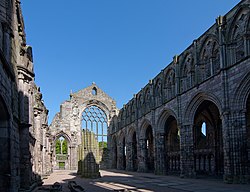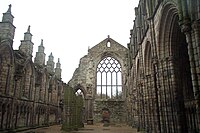Holyrood Abbey
| Holyrood Abbey | |
|
Midlothian | |
|---|---|
 The ruins of Holyrood Abbey | |
| Location | |
| Grid reference: | NT26947396 |
| Location: | 55°57’11"N, 3°10’18"W |
| Order: | Augustinian |
| History | |
| Founder: | King David I |
| Information | |
| Owned by: | Historic Scotland |
Holyrood Abbey is a ruined abbey of the Augustinian Canons Regular in Edinburgh, Midlothian. The abbey was founded in 1128 by King David I; one of that king's any monastic foundations.
During the 15th century, the abbey guesthouse was developed into a royal residence, and after the Reformation the Palace of Holyroodhouse was expanded further.

The abbey church was used as a parish church until the 17th century, and has been ruined since the 18th century. The remaining walls of the abbey lie adjacent to the palace, at the eastern end of Edinburgh's Royal Mile. The site of the abbey is protected as a scheduled monument.[1]
History

Legend relates that in 1127, while King David I was hunting in the forests to the east of Edinburgh during the Feast of the Cross, he was thrown from his horse after it had been startled by a hart. According to variations of the story, the king was saved from being gored by the charging animal when it was startled either by the miraculous appearance of a holy cross descending from the skies, or by sunlight reflected from a crucifix which suddenly appeared between the hart's antlers while the king attempted to grasp them in self-defence. As an act of thanksgiving for his escape, David I founded Holyrood Abbey on the site in 1128.[2]
In the church was preserved, in a golden reliquary, an object said to be a fragment of the True Cross brought by David's mother, St. Margaret, from Waltham Abbey, and known thereafter as the 'Black Rood of Scotland'. At the battle of Neville's Cross, in 1346, this precious relic fell into the hands of the English, and it was placed in Durham Cathedral, from where it disappeared at the Reformation.
The abbey was originally served by a community of Augustinian Canons Regular from Merton Priory. The layout of the original church at Holyrood, now known only from excavations, probably came from the 1125 church at the priory.[2] In 1177 the papal legate Vivian held council here. In 1189 the nobles and prelates of Scotland met here to discuss raising a ransom for William the Lion.[2]

The original abbey church of Holyrood was largely reconstructed between 1195 and 1230.[2] The completed building consisted of a six-bay aisled choir, three-bay transepts with a central tower above, and an eight-bay aisled nave with twin towers at its west front.[3] Some scholars believe the high vaults to be sexpartite (though this is not clearly supported by the 17th century illustrations of the interior). Such a design was probably archaic in that period, and difficult to execute or maintain. Evidence of the quality of the construction work has remained on the south aisle vaults, which are set on an almost square plan of 14 feet, but built relatively roughly, with thin flagstones and not much attention to keeping the vertices straight. They were probably plastered, with exposed thin ribs.
Among the chief benefactors of Holyrood during the four centuries of its existence as a religious house were Kings David I and II; Robert, Bishop of St. Andrews; and Fergus, Lord of Galloway.
The Parliament of Scotland met at the abbey in 1256, 1285, 1327, 1366, 1384, 1389 and 1410. In 1326 Robert the Bruce held parliament here, and there is evidence that Holyrood was being used as a royal residence by 1329.[2] The Treaty of Edinburgh–Northampton (1328), which ended the First War of Scottish Independence, was signed by Robert I in the "King's Chamber" at Holyrood in March 1328. The abbey's position close to Edinburgh Castle meant that it was often visited by Scotland's kings, who were lodged in the guest house situated to the west of the abbey cloister. In the mid-15th century, with the emergence of Edinburgh as the main seat of the royal court and the chief city in the kingdom, the Kings of Scots increasingly used the accommodation at Holyrood for secular purposes. James II and his twin brother Alexander, Duke of Rothesay, were born there in October 1430. James was also crowned at Holyrood in 1437 and building works were carried out before his marriage there in 1449.[4][5] Between 1498 and 1501, James IV constructed a royal palace at Holyrood, adjacent to the abbey cloister.
16th century onwards
Royal influence over the abbey further increased when in 1538 Robert Stewart, the infant, illegitimate son of James V, was appointed as commendator of Holyrood.[3][6]

During the War of the Rough Wooing, the invading English armies of the Earl of Hertford inflicted structural damage on Holyrood Abbey in 1544 and 1547. Lead was stripped from the roof, the bells were removed, and the contents of the abbey were plundered. In 1559, during the Scottish Reformation, the abbey suffered further damage when a mob destroyed the altars and looted the rest of the church.[7] With the reformation and the end of monastic services, the east end of the abbey church became redundant. In 1569, Adam Bothwell, the commendator of Holyrood, informed the General Assembly of the Church of Scotland that the east end was in such a state of disrepair that the choir and transept should be demolished. This was done the following year, retaining only the nave, which by then was serving as the parish church of the burgh of Canongate. Between 1570 and 1573 an east gable was erected, closing the east end of the former nave, all but two of the windows in the nave were blocked up, the royal tombs were removed to a new royal burial vault in the south aisle and the old east end was demolished.[7]
The abbey was extensively remodelled in 1633 for the coronation of Charles I.

In 1686, James VII established a Jesuit college within Holyrood Palace. The following year, the Protestant congregation was moved to the new Kirk of the Canongate, and the abbey was converted into a Roman Catholic Chapel Royal and the chapel of the Order of the Thistle.[8] The abbey church was remodelled according to the plans of James Smith, and was fitted with elaborate thrones and stalls for the individual Knights of the Thistle, carved by Grinling Gibbons. However, in 1688, following the Glorious Revolution, the Edinburgh mob broke into the abbey, entered the Chapel Royal and desecrated the royal tombs.[8][9]
The association of the church with these events and the absence of a royal court left the building out of public interest. The ageing timber roof trusses were replaced by stone vaults and outer stone slabs in 1758-60 by the architect John Douglas and the stonemason James McPherson. However this proved to be a disastrous change. The excessive weight of the stone could not be supported by the walls. The strength of stone vaults depends on the containment of their thrusts, which the decayed flying buttresses could not contain any more, and a small movement (less than one-thirtieth of the span) can cause severe deformation and collapse.[10][11] It took six years for the deformation to become alarming. This forced the Barons of the Exchequer (the administrators of the Palace) to close the church on safety grounds in 1766, following inspection by William Mylne.
On 2 December 1768 the roof collapsed in two stages,[12] leaving the abbey as it currently stands, a roofless ruin.
The restoration of the abbey has been proposed several times since the 18th century – in 1835 by the architect James Gillespie Graham as a meeting place for the General Assembly of the Church of Scotland and, in 1906, as a chapel for the Knights of the Thistle – but both proposals were rejected.[9]
Events
Coronations
Holyrood Abbey was the site of a number of coronations of Kings and of their queens: that of King James II in 1437, Margaret Tudor in 1504, Queen Mary of Guise in 1540, Anne of Denmark in 1590, and King Charles I in 1633.
Weddings
The abbey was the site of numerous royal weddings. These include:
- James II and Mary of Guelders in 1449
- James III and Margaret of Denmark in 1469
- James IV and Margaret Tudor in 1503
Births
- King James II in 1430
Burials
The abbey was the site of many royal funerals and interments, mostly in the east bay of the south aisle, known as the "Royal Vault". Royals originally interred here include:
- King David II in 1371
- King James II in 1460
- Arthur, Duke of Rothesay (second son of James IV) in 1510
- Madeleine of Valois in 1537, teenage bride of James V
- James, Duke of Rothesay (eldest son of James V) in 1541
- Arthur, Duke of Albany (second son of James V) in 1541
- King James V in 1542
- Henry Stuart, Lord Darnley in 1567
- Margaret (second daughter of James VI) in 1600
- Mary of Guelders in 1463 (who was originally buried in Trinity College Kirk)
In art
The abbey ruins are depicted in the 19th-century painting The Ruins of Holyrood Chapel by the French artist Louis Daguerre.[13]
In literature
In March 1825, a moonlit scene entitled 'Ruins of Holyrood Chapel' was put into the Diorama, Regent's Park, London, inspiring the poem 'Holyrood' by Letitia Elizabeth Landon. Although the article in the Gazette does not say so specifically, this is presumably the display mentioned in the article on the work by Louis Daguerre above.[14]
See also
Outside links
| ("Wikimedia Commons" has material about Holyrood Abbey) |
- Holyrood Abbey, precinct and associated remains - scheduled monument detail (Historic Environment Scotland)
- Holyrood Abbey Church
References
- ↑ Holyrood Abbey and Palace gardens - Historic Scotland
- ↑ 2.0 2.1 2.2 2.3 2.4 Nikolaus Pevsner: The Buildings of Scotland: Lothian, except Edinburgh, 1978 Penguin Books ISBN 978-0-300-09626-2
- ↑ 3.0 3.1 Fawcett, p.62
- ↑ Gallagher, p.1079.
- ↑ Fawcett, p.62.
- ↑ Gallagher, p.1080.
- ↑ 7.0 7.1 Gallagher, p.1084.
- ↑ 8.0 8.1 Burnett and Bennett. p.7.
- ↑ 9.0 9.1 Gallagher, p.1085.
- ↑ Theodossopoulos, Dimitris: 'Case Study of the Failure of a Cross Vault: Church of Holyrood Abbey': Journal of Architectural Engineering, ASCE; Volume 9, Issue 3 (2003)
- ↑ Theodossopoulos, D. 2016 pp. 954-974
- ↑ 'Holyroodhouse Abbey falls down: The Scots Magazine 3 December 1768, vol. XXX, 667
- ↑ "'Ruins of Holyrood Chapel', by Louis Daguerre (1787-1851)". National Museums Liverpool. http://www.liverpoolmuseums.org.uk/picture-of-month/displaypicture.asp?venue=2&id=12.
- ↑ The London Literary Gazette, 26 March 1825.
- Burnett, Charles and Bennett, Helen: 'The Green Mantle: a celebration of the revival in 1687 of the Most Ancient and Most Noble Order of the Thistle' (1987)
- Fawcett, Richard: 'The Palace of Holyroodhouse: official guide' (HMSO, Edinburgh, 1988)
- Gallagher, Dennis, 'Holyrood Abbey: the disappearance of a monastery': Proceedings of the Society of Antiquaries of Scotland, 128 (1998), pp. 1079–1099.
- Theodossopoulos, Dimitris: 'The Catastrophic Repairs of Holyrood Abbey Church in 1760': International Journal of Architectural Heritage 10(7), 2016, pp. 954–974
